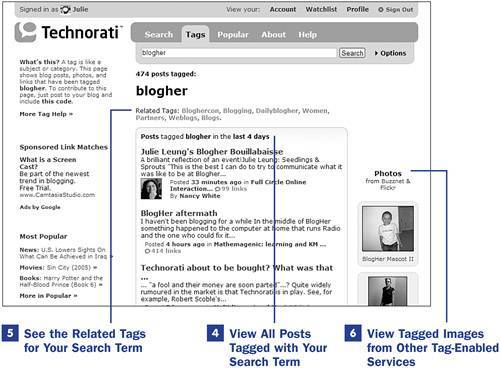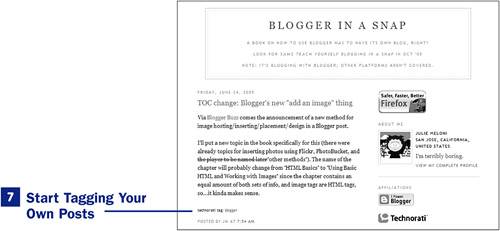Section 53. Embracing Folksonomy
53. Embracing FolksonomyFolksonomy refers to the collection and categorization of items by the people doing the collecting and categorization. In other words, it's the "folks"average people like you and mewho determine their own classifications and not some hifalutin' Master Classifier of All Things. Instead of writing a blog post about web design standards and looking in some reference guide how to best classify the information I just wrote, I can categorize it as I see fitI can tag the entry with CSS, web design, W3C standards, XHTML, and so on. Users apply categorizations through the use of tags. In some blog publishing tools, users can specifically categorize their posts, which are then interpreted as tags by blog-specific search engines, such as Technorati (http://www.technorati.com/), that rely heavily on tags to organize content. Blogger users must manually add tags to their posts, as you'll see in step 7 later in this section. In the meantime, take a look at steps 16 to get a better understanding of the concept of folksonomy in action.
Although I consider Technorati the leader in the indexing and implementation of folksonomy-based content searching, other search engines such as IceRocket (http://www.icerocket.com/) also employ some manner of tag-based searching. del.icio.us, the social bookmarks management service, also relies on tagging to organize user content, as do image management services such as Flickr (http://www.flickr.com/) and Buzznet (http://www.buzznet.com/). Tagging is popping up everywhere!
If you plan to use tags and want to ensure that your posts are indexed in Technorati, be sure to register with Technorati and claim your blog. Go to http://www.technorati.com/signup/ to start this process, if you haven't already. A tag is nothing more than an <a></a> link with an additional attribute in the mix. For example: <a href="http://some.link.to/some_page" rel="tag">tagname_goes_here</a> Here is a more specific example: <a href="http://www.blogger.com/" rel="tag">blogger</a> After adding a tag to your post, such as the one just shown, ping Technorati at http://www.technorati.com/ping/ so that it knows to add your recently published blog to its indexing queue. In the preceding example, you'll notice I linked to http://www.blogger.com/ instead of the Technorati tag page for blogger. You can link to any page you want in the href attribute of the <a></a> tag. The indexing mechanism looks for the rel="tag" attribute, and then looks for the term between the <a></a> tags. On my own blog, I use the method of linking to the Technorati tag page within my tagged elements, simply because it provides me with an easy way to jump to a category cosmos in which I am interested. For instance, when tagging a post with the blogger tag, I would use the following link: <a href="http://www.technorati.com/tag/blogger" rel="tag">blogger</a> A tag-indexing mechanism such as Technorati doesn't care what you put within the HRef attribute of your link. All it looks for is the rel="tag" attribute and the text between the <a></a> tags. Everyone is different, so link to whatever you like, and tag your posts where appropriate to help build self-filtered search results. |
EAN: 2147483647
Pages: 124
 NOTE
NOTE

